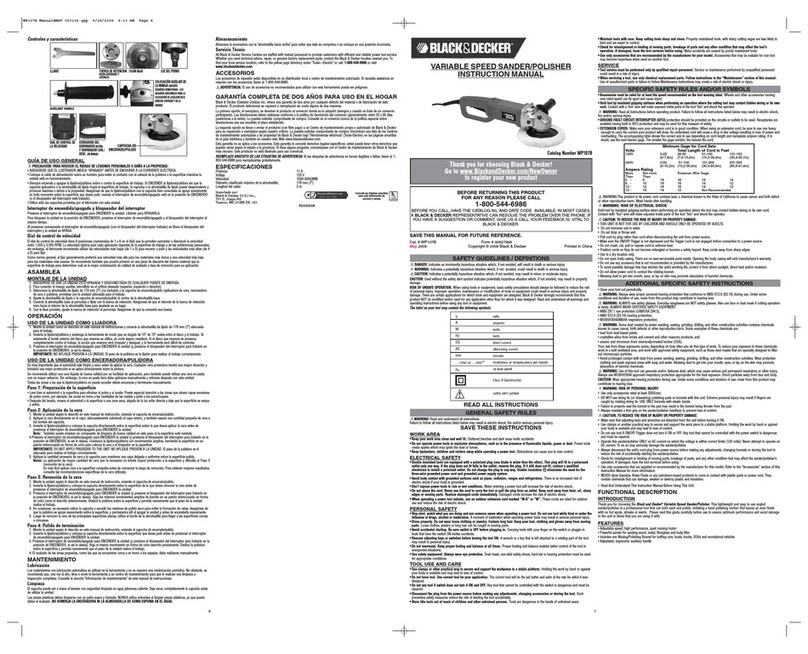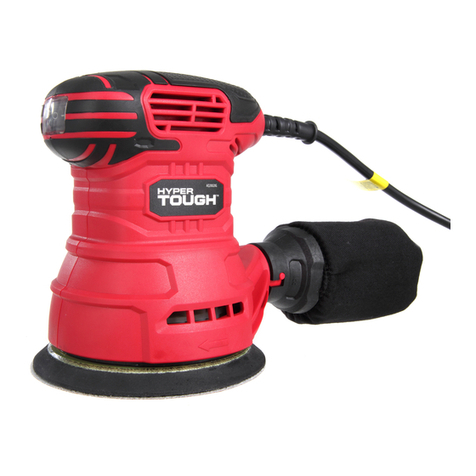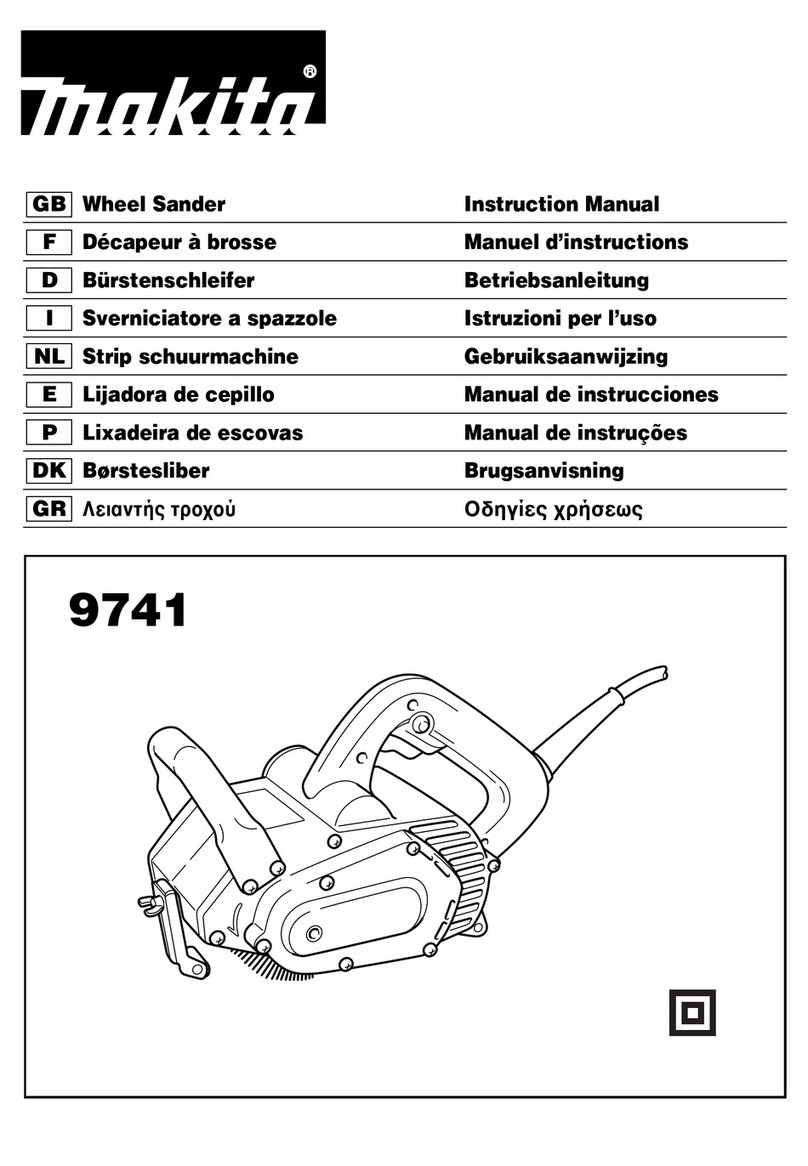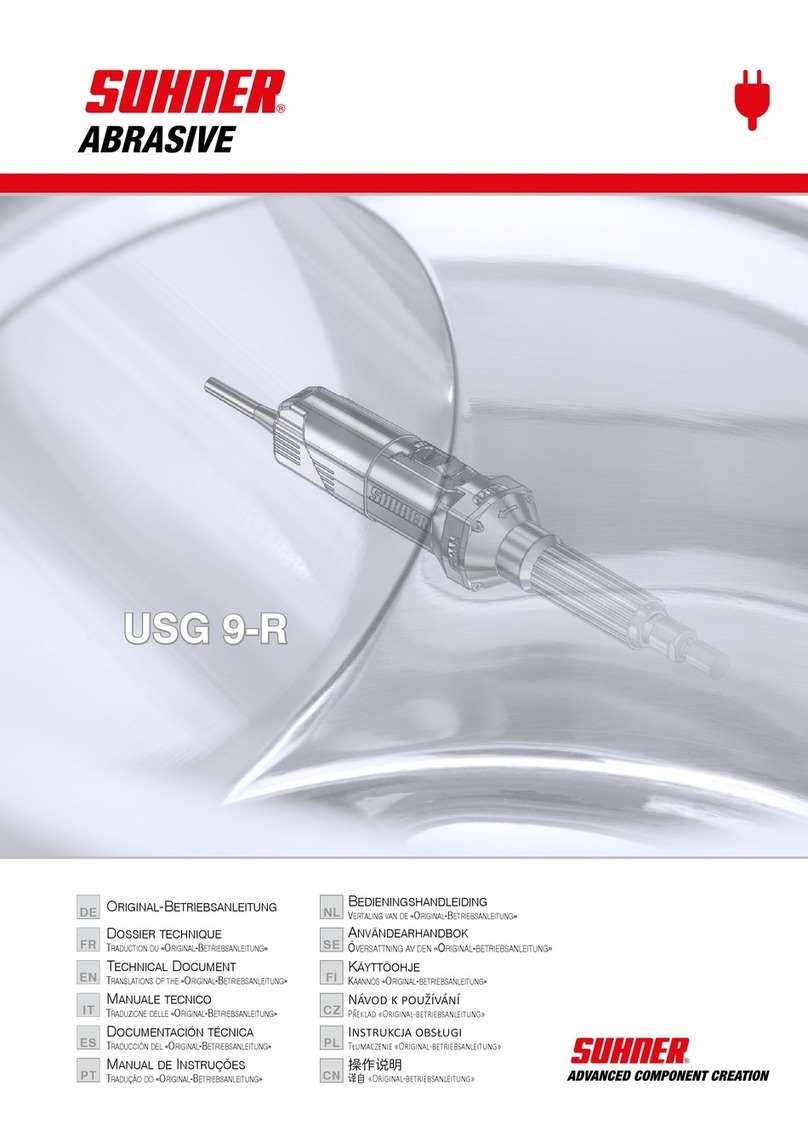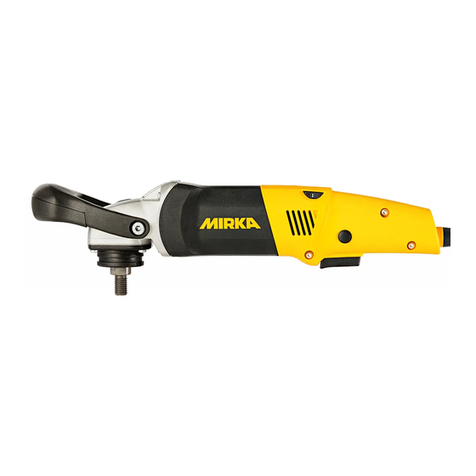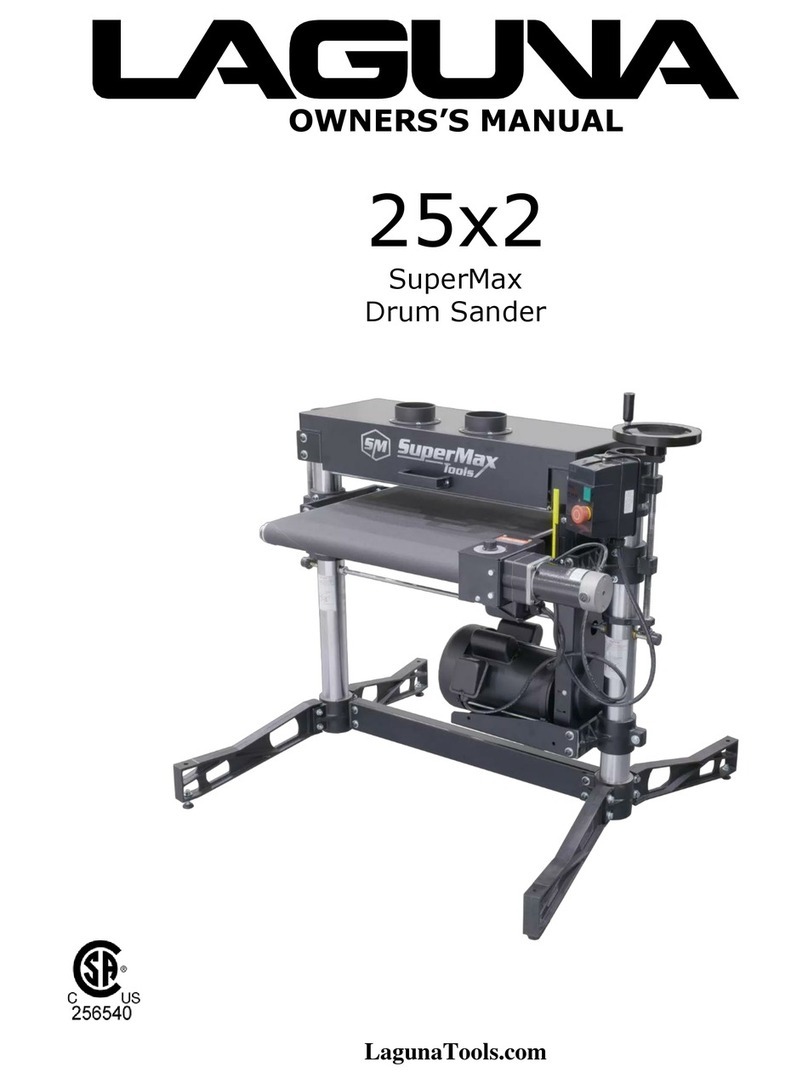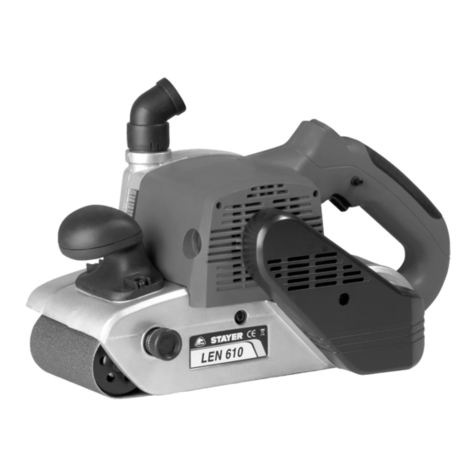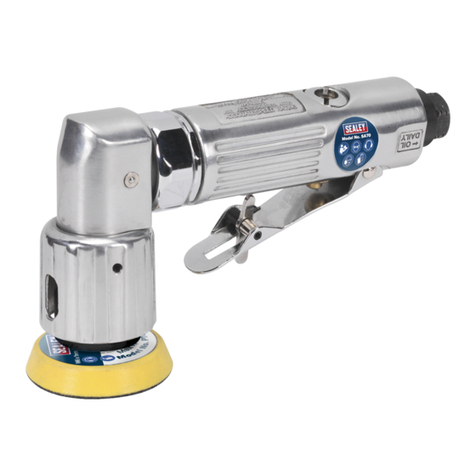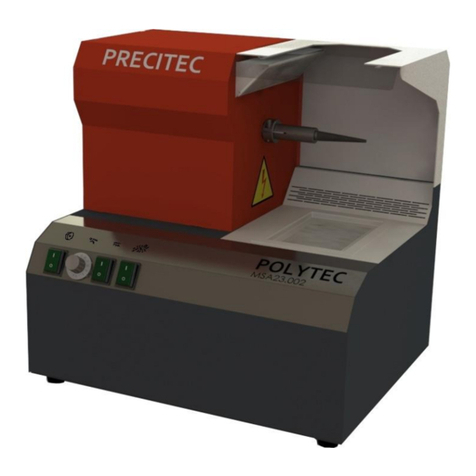Southbend SB1097 User manual

®
A Tradition of Excellence
South Bend Tools
© April, 2021 by South Bend Tools For Machines Mfd. Since 02/21
MODEL SB1097
6" X 108" VARIABLE-SPEED
OSCILLATING EDGE SANDER
OWNER'S MANUAL

Customer Service
We stand behind our machines. If you have any service questions, parts requests or general questions
about your purchase, feel free to contact us.
South Bend Tools
P.O. Box 2027
Bellingham, WA 98227
Phone: (360) 734-1540
Fax: (360) 676-1075 (International)
Fax: (360) 734-1639 (USA Only)
Email: [email protected]
Updates
For your convenience, any updates to this manual will be available to download free of charge
through our website at:
www.southbendtools.com
Scope of Manual
This manual helps the reader understand the machine, how to prepare it for operation, how to control
it during operation, and how to keep it in good working condition. We assume the reader has a basic
understanding of how to operate this type of machine, but that the reader is not familiar with the
controls and adjustments of this specific model. As with all machinery of this nature, learning the
nuances of operation is a process that happens through training and experience. If you are not an
experienced operator of this type of machinery, read through this entire manual, then learn more
from an experienced operator, schooling, or research before attempting operations. Following this
advice will help you avoid serious personal injury and get the best results from your work.
Manual Feedback
We've made every effort to be accurate when documenting this machine. However, errors sometimes
happen or the machine design changes after the documentation process—so
the manual may not
exactly match your machine.
If a difference between the manual and machine leaves you in doubt,
contact our
customer service for clarification.
We highly value customer feedback on our manuals. If you have a moment, please share your
experience using this manual. What did you like about it? Is there anything you would change to
make it better? Did it meet your expectations for clarity, professionalism, and ease-of-use?
South Bend Tools
C
/O Technical Documentation Manager

Table of Contents
ACCESSORIES.............................................................. 35
MAINTENANCE ............................................................. 37
Maintenance Schedule....................................... 37
Cleaning & Protecting .......................................37
Lubrication......................................................... 38
Cleaning Sanding Belt.......................................41
Machine Storage ................................................41
SERVICE........................................................................... 42
Calibrating Platen Tilt ...................................... 42
Calibrating Miter Gauge ...................................43
Removing Drive Roller ......................................44
TROUBLESHOOTING................................................. 45
ELECTRICAL................................................................... 47
Electrical Safety Instructions ...........................47
Wiring Diagram .................................................48
Electrical Component Photos ............................ 49
PARTS................................................................................ 51
Sanding Head & Table ......................................51
Base & Gearbox .................................................54
Machine Labels ..................................................56
WARRANTY..................................................................... 57
INTRODUCTION...............................................................2
Identification ........................................................2
Description of Controls & Components ..............3
Product Specifications ......................................... 5
SAFETY................................................................................7
Understanding Risks of Machinery .................... 7
Basic Machine Safety ..........................................7
Additional Oscillating Edge Sander Safety........ 9
PREPARATION .............................................................. 10
Preparation Overview........................................ 10
Required for Setup.............................................10
Power Supply Requirements............................. 11
Unpacking ..........................................................13
Inventory ............................................................13
Cleaning & Protecting .......................................14
Location ..............................................................15
Lifting & Moving................................................16
Assembly ............................................................17
Dust Collection................................................... 20
Test Run .............................................................20
OPERATION.................................................................... 23
Operation Overview........................................... 23
Stock Inspection & Requirements.....................24
Sanding Tips ......................................................24
Choosing Sanding Belts.....................................25
Installing/Changing Sanding Belts...................25
Pre-Tracking Belt ..............................................27
Checking/Adjusting Belt Tracking.................... 28
Adjusting Main Table ........................................ 29
Adjusting Miter Gauge ...................................... 29
Edge & End Sanding ......................................... 30
Adjusting Platen Tilt ......................................... 30
Bevel Sanding ....................................................31
Installing Fence .................................................31
Face Sanding......................................................32
Installing Sanding Drum...................................32
Adjusting End Table.......................................... 34
Contour Sanding ................................................34

INTRODUCTION
-2-
For Machines Mfd. Since 02/21
South Bend Tools
Model SB1097 INTRODUCTION
Identification
For Your Own Safety, Read Instruction Manual Before Operating Sander
a) Wear eye protection.
b) Support workpiece with miter gauge, backstop, or worktable.
c) Maintain 1⁄16" maximum clearance between table and sanding belt.
d) Avoid kickback by sanding in accordance with the directional arrows.
MotorMotor
Main TableMain Table
Main TableMain Table
HeightHeight
HandwheelHandwheel
MiterMiter
GaugeGauge
Platen TiltPlaten Tilt
Lock HandleLock Handle
Touch ScreenTouch Screen
Digital ReadoutDigital Readout
Belt AccessBelt Access
DoorDoor
DustDust
PortPort
(1 of 2)(1 of 2)
EndEnd
TableTable
End TableEnd Table
HeightHeight
Lock HandleLock Handle
Belt Access DoorBelt Access Door
Lock KnobLock Knob
(1 of 2)(1 of 2)
Main TableMain Table
Lock LeverLock Lever
(1 of 2)(1 of 2)
SandingSanding
SpindleSpindle
Main TableMain Table
AdjustmentAdjustment
Lock HandleLock Handle
(1 of 2)(1 of 2)
BackstopBackstop
CabinetCabinet
E-Stop ButtonE-Stop Button
w/Disablingw/Disabling
KeyKey
Belt AccessBelt Access
DoorDoor
E-Stop ButtonE-Stop Button
StorageStorage
CompartmentCompartment

South Bend Tools
For Machines Mfd. Since 02/21 Model SB1097
-3-
INTRODUCTION
Description of Controls
& Components
Refer to Figures 1–7 and the following
descriptions to become familiar with the basic
controls and components used to operate this
machine.
A. Cabinet E-Stop Button w/Disabling Key:
Turns machine OFF when pressed. Twist
clockwise to reset. When key is removed,
button is disabled and machine cannot start.
B. Touch Screen Digital Readout: Turns
machine ON, displays speed setting, and
adjusts sanding belt speed.
AABB
FigureFigure 1. Main electrical controls.. Main electrical controls.
Serious personal injury could occur if
you connect the machine to power before
completing the setup process. DO NOT
connect power until instructed to do so later
in this manual.
Untrained users have an increased risk
of seriously injuring themselves with this
machine. Do not operate this machine until
you have understood this entire manual and
received proper training.
H. Belt Access Door E-Stop Button: Turns
machine OFF when pressed. Twist clockwise
to reset.
HH
FigureFigure 3. Belt access door E-Stop button location.. Belt access door E-Stop button location.
C. Pre-Set Speed Buttons: Change speed
setting to 500, 1100, 2200, or 3300 RPM
when pressed.
D. Speed Setting: Displays current RPM.
E. Adjustment Arrows: Adjust speed setting up
or down in 50 RPM intervals.
F. OFF Button: Turns machine OFF.
G. ON Button: Turns machine ON.
FigureFigure 2. Touch screen controls.. Touch screen controls.
CCDD
EE
FFGG

-4-
For Machines Mfd. Since 02/21
South Bend Tools
Model SB1097 INTRODUCTION
Q. Belt Access Door Lock Knobs: Tighten to
lock belt access door and loosen to open belt
access door.
R. Belt Access Door: Opens and closes to allow
for belt replacement and maintenance.
S. Miter Gauge: Adjusts from 0–60 degrees to
support workpiece against sanding belt and
table when platen is in vertical position.
T. Backstop: Supports workpiece against
sanding belt with platen at any angle.
RR
FigureFigure 7. Additional sanding components.. Additional sanding components.
QQ
QQ
SSTT
P. Fence: Supports workpiece when platen is in
horizontal position.
FigureFigure 6. Horizontal sanding fence.. Horizontal sanding fence.
PP
I. Main Table Height Handwheel: Adjusts main
table height.
J. Main Table Height Lock Handles: Tighten to
lock main table height and loosen to adjust
height.
K. Main Table Lock Levers: Tighten to lock main
table position in relation to platen and loosen
to adjust clearance between them.
L. Platen Tilt Lock Handle: Tightens to lock
platen tilt and loosens to adjust tilt.
II
JJ
LL
KK
FigureFigure 4. Main table and platen adjustment controls.. Main table and platen adjustment controls.
M. Sanding Spindle: Provides curved sanding
surface for contour sanding.
N. End Table: Supports workpiece during
contour sanding operations.
O. End Table Height Lock Handle: Tightens to
lock end table height and loosens to adjust
end table height.
NN
OO
FigureFigure 5. Sanding spindle controls and components.. Sanding spindle controls and components.
MM

South Bend Tools
For Machines Mfd. Since 02/21 Model SB1097
-5-
INTRODUCTION
Product Specifications
Model SB1097 Page 1 of 2
Model SB1097
6" x 108" VS Oscillating Edge Sander
Product Dimensions
Weight............................................................................................................................................................. 495 lbs.
Width (side-to-side) x Depth (front-to-back) x Height..................................................................... 60 x 28 x 43 in.
Footprint (Length x Width)................................................................................................................. 32 x 19-1/2 in.
Shipping Dimensions
Type.......................................................................................................................................................... Wood Crate
Content.......................................................................................................................................................... Machine
Weight............................................................................................................................................................. 597 lbs.
Length x Width x Height................................................................................................................... 58 x 30 x 44 in.
Must Ship Upright................................................................................................................................................ Yes
Electrical
Power Requirement......................................................................................................... 220V, Single-Phase, 60 Hz
Full-Load Current Rating.................................................................................................................................... 19A
Minimum Circuit Size.......................................................................................................................................... 30A
Connection Type..................................................................................................................................... Cord & Plug
Power Cord Included............................................................................................................................................. Yes
Power Cord Length............................................................................................................................................ 68 in.
Power Cord Gauge......................................................................................................................................... 14 AWG
Plug Included........................................................................................................................................................ Yes
Included Plug Type............................................................................................................................................ L6-30
Switch Type............................................................................................... Magnetic Switch w/Overload Protection
Inverter (VFD) Type............................................................................................................ Kinco CV100-2S-0022G
Inverter (VFD) Size............................................................................................................................................ 3 HP
Motors
Main
Horsepower............................................................................................................................................... 3 HP
Phase.................................................................................................................................................... 3-Phase
Amps.......................................................................................................................................................... 9.5A
Speed................................................................................................................................................ 1725 RPM
Type........................................................................................................................................ TEFC Induction
Power Transfer ...................................................................................................................................... Direct
Bearings................................................................................................ Shielded & Permanently Lubricated
Main Specifications
Operation Information
Sanding Belt Speed................................................................................................................. 600 - 6000 FPM
Sanding Belt Oscillations....................................................................................................................... 1/4 in.
Sanding Belt Length.............................................................................................................................. 108 in.
Sanding Belt Width................................................................................................................................... 6 in.
Sanding Belt Tilt.............................................................................................................................. 0 - 90 deg.
Model SB1097 Page 1 of 2
Model SB1097
6" x 108" VS Oscillating Edge Sander
Product Dimensions
Weight............................................................................................................................................................. 495 lbs.
Width (side-to-side) x Depth (front-to-back) x Height..................................................................... 60 x 28 x 43 in.
Footprint (Length x Width)................................................................................................................. 32 x 19-1/2 in.
Shipping Dimensions
Type.......................................................................................................................................................... Wood Crate
Content.......................................................................................................................................................... Machine
Weight............................................................................................................................................................. 597 lbs.
Length x Width x Height................................................................................................................... 58 x 30 x 44 in.
Must Ship Upright................................................................................................................................................ Yes
Electrical
Power Requirement......................................................................................................... 220V, Single-Phase, 60 Hz
Full-Load Current Rating.................................................................................................................................... 19A
Minimum Circuit Size.......................................................................................................................................... 30A
Connection Type..................................................................................................................................... Cord & Plug
Power Cord Included............................................................................................................................................. Yes
Power Cord Length............................................................................................................................................ 68 in.
Power Cord Gauge......................................................................................................................................... 14 AWG
Plug Included........................................................................................................................................................ Yes
Included Plug Type............................................................................................................................................ L6-30
Switch Type............................................................................................... Magnetic Switch w/Overload Protection
Inverter (VFD) Type............................................................................................................ Kinco CV100-2S-0022G
Inverter (VFD) Size............................................................................................................................................ 3 HP
Motors
Main
Horsepower............................................................................................................................................... 3 HP
Phase.................................................................................................................................................... 3-Phase
Amps.......................................................................................................................................................... 9.5A
Speed................................................................................................................................................ 1725 RPM
Type........................................................................................................................................ TEFC Induction
Power Transfer ...................................................................................................................................... Direct
Bearings................................................................................................ Shielded & Permanently Lubricated
Main Specifications
Operation Information
Sanding Belt Speed................................................................................................................. 600 - 6000 FPM
Sanding Belt Oscillations....................................................................................................................... 1/4 in.
Sanding Belt Length.............................................................................................................................. 108 in.
Sanding Belt Width................................................................................................................................... 6 in.
Sanding Belt Tilt.............................................................................................................................. 0 - 90 deg.

-6-
For Machines Mfd. Since 02/21
South Bend Tools
Model SB1097 INTRODUCTION
Model SB1097 Page 2 of 2
Table Information
Table Length...................................................................................................................................... 35-1/2 in.
Table Width.............................................................................................................................................. 12 in.
Table Thickness................................................................................................................................... 1-1/2 in.
Table Travel............................................................................................................................................... 4 in.
Floor To Table Height.......................................................................................................... 35-3/4 - 39-3/4 in.
End Table Length.............................................................................................................................. 11-1/2 in.
End Table Width...................................................................................................................................... 10 in.
End Table Thickness.............................................................................................................................. 3/4 in.
End Table Travel..................................................................................................................................... 10 in.
Platen Information
Platen Type............................................................................................................................ Graphite Coated
Platen Length.................................................................................................................................... 39-3/4 in.
Platen Width........................................................................................................................................ 6-3/4 in.
Construction
Table.................................................................................................................... Precision-Ground Cast Iron
Frame........................................................................................................................................................ Steel
Base........................................................................................................................................................... Steel
Drive Roller..................................................................................................................................... Aluminum
Idler Roller............................................................................................................................................ Rubber
Miter Block...................................................................................................................................... Aluminum
Paint Type/Finish.................................................................................................................... Powder Coated
Other Related Information
Number of Dust Ports..................................................................................................................................... 2
Dust Port Size............................................................................................................................................ 4 in.
Belt Release............................................................................................................................... Quick Release
Drive Roller Size........................................................................................................................................ 7 in.
Idler Roller Size................................................................................................................................... 3-7/8 in.
Other
Country of Origin ........................................................................................................................................... Taiwan
Warranty ........................................................................................................................................................ 2 Years
Approximate Assembly & Setup Time .................................................................................................. 15 Minutes
Serial Number Location .............................................................................................................................. ID Label
Sound Rating ............................................................................................................................................. 90 - 92 dB
Features
Sanding Surfaces Tilt Vertical and Horizontal
T-Slot Table and Miter Gauge
Quick-Release Belt Lever
Graphite-Coated Platen
Oscillating Sanding Surfaces
Sanding Belt Oscillates at 52 Cycles per Minute
Includes 3 Sanding Drums: 1-1/2" x 4-1/2", 2" x 4-1/2", and 3" x 4-1/2"
Platen Tilts 0 to 90 Degrees
Variable-Speed Motor with Touch Screen Controls

SAFETY
South Bend Tools
For Machines Mfd. Since 02/21 Model SB1097
-7-
SAFETY
Understanding Risks of Machinery
Operating all machinery and machining equipment can be dangerous or relatively safe depending
on how it is installed and maintained, and the operator's experience, common sense, risk awareness,
working conditions, and use of personal protective equipment (safety glasses, respirators, etc.).
The owner of this machinery or equipment is ultimately responsible for its safe use. This
responsibility includes proper installation in a safe environment, personnel training and usage
authorization, regular inspection and maintenance, manual availability and comprehension,
application of safety devices, integrity of cutting tools or accessories, and the usage of approved
personal protective equipment by all operators and bystanders.
The manufacturer of this machinery or equipment will not be held liable for injury or property
damage from negligence, improper training, machine modifications, or misuse. Failure to read,
understand, and follow the manual and safety labels may result in serious personal injury, including
amputation, broken bones, electrocution, or death.
The signals used in this manual to identify hazard levels are as follows:
Death or catastrophic
harm WILL occur.
Moderate injury or fire
MAY occur.
Death or catastrophic
harm COULD occur.
Machine or property
damage may occur.
Basic Machine Safety
Owner’s Manual: All machinery and machining
equipment presents serious injury hazards
to untrained users. To reduce the risk of
injury, anyone who uses THIS item MUST
read and understand this entire manual
before starting.
Personal Protective Equipment: Operating or
servicing this item may expose the user
to flying debris, dust, smoke, dangerous
chemicals, or loud noises. These hazards
can result in eye injury, blindness, long-
term respiratory damage, poisoning,
cancer, reproductive harm or hearing loss.
Reduce your risks from these hazards
by wearing approved eye protection,
respirator, gloves, or hearing protection.
Trained/Supervised Operators Only: Untrained
users can seriously injure themselves
or bystanders. Only allow trained and
properly supervised personnel to operate
this item. Make sure safe operation
instructions are clearly understood. If
electrically powered, use padlocks and
master switches, and remove start switch
keys to prevent unauthorized use or
accidental starting.
Guards/Covers: Accidental contact with
moving parts during operation may cause
severe entanglement, impact, cutting,
or crushing injuries. Reduce this risk by
keeping any included guards/covers/doors
installed, fully functional, and positioned
for maximum protection.

-8-
For Machines Mfd. Since 02/21
South Bend Tools
Model SB1097 SAFETY
Entanglement: Loose clothing, gloves, neckties,
jewelry or long hair may get caught in
moving parts, causing entanglement,
amputation, crushing, or strangulation.
Reduce this risk by removing/securing
these items so they cannot contact moving
parts.
Mental Alertness: Operating this item with
reduced mental alertness increases the
risk of accidental injury. Do not let a
temporary influence or distraction lead to a
permanent disability! Never operate when
under the influence of drugs/alcohol, when
tired, or otherwise distracted.
Safe Environment: Operating electrically
powered equipment in a wet environment
may result in electrocution; operating near
highly flammable materials may result in a
fire or explosion. Only operate this item in
a dry location that is free from flammable
materials.
Electrical Connection: With electically powered
equipment, improper connections to the
power source may result in electrocution
or fire. Always adhere to all electrical
requirements and applicable codes when
connecting to the power source. Have all
work inspected by a qualified electrician to
minimize risk.
Disconnect Power: Adjusting or servicing
electrically powered equipment while it
is connected to the power source greatly
increases the risk of injury from accidental
startup. Always disconnect power
BEFORE any service or adjustments,
including changing blades or other tooling.
Secure Workpiece/Tooling: Loose workpieces,
cutting tools, or rotating spindles can
become dangerous projectiles if not
secured or if they hit another object during
operation. Reduce the risk of this hazard
by verifying that all fastening devices are
properly secured and items attached to
spindles have enough clearance to safely
rotate.
Chuck Keys or Adjusting Tools: Tools used to
adjust spindles, chucks, or any moving/
rotating parts will become dangerous
projectiles if left in place when the machine
is started. Reduce this risk by developing
the habit of always removing these tools
immediately after using them.
Work Area: Clutter and dark shadows increase
the risks of accidental injury. Only operate
this item in a clean, non-glaring, and well-
lighted work area.
Properly Functioning Equipment: Poorly
maintained, damaged, or malfunctioning
equipment has higher risks of causing
serious personal injury compared to
those that are properly maintained.
To reduce this risk, always maintain
this item to the highest standards and
promptly repair/service a damaged or
malfunctioning component. Always follow
the maintenance instructions included in
this documentation.
Unattended Operation: Electrically powered
equipment that is left unattended while
running cannot be controlled and is
dangerous to bystanders. Always turn the
power OFF before walking away.
Health Hazards: Certain cutting fluids and
lubricants, or dust/smoke created when
cutting, may contain chemicals known to
the State of California to cause cancer,
respiratory problems, birth defects,
or other reproductive harm. Minimize
exposure to these chemicals by wearing
approved personal protective equipment
and operating in a well ventilated area.
Difficult Operations: Attempting difficult
operations with which you are unfamiliar
increases the risk of injury. If you
experience difficulties performing the
intended operation, STOP! Seek an
alternative method to accomplish the
same task, ask a qualified expert how the
operation should be performed, or contact
our Technical Support for assistance.

South Bend Tools
For Machines Mfd. Since 02/21 Model SB1097
-9-
SAFETY
Additional Oscillating Edge Sander Safety
Feeding Workpiece. Forcefully jamming
workpiece into sanding surface could cause
workpiece to be aggressively grabbed and
pull your hands into sanding surface. Firmly
grasp workpiece in both hands and ease it
into sandpaper using light pressure.
Small Workpieces. Small workpieces are
difficult to control and require close support
near sanding surface. Always use a jig or
other holding device when sanding small
workpieces, and keep hands and fingers at
least 2" away from sanding surface.
Workpiece Inspection. Nails, staples, knots, or
other imperfections in workpiece can be
dislodged and thrown from sander at high
rate of speed into operator or bystanders, or
cause damage to sandpaper or sander. Never
try to sand stock that has embedded foreign
objects or questionable imperfections.
Sandpaper Condition. Worn or damaged
sandpaper not only produces poor sanding
results, but could fly apart, aggressively grab
workpiece, and throw debris at the operator.
Always inspect sandpaper before operation
and replace if worn or damaged.
Sanding Dust & Dust Collection. Sanding creates
large amounts of dust and flying particles
that can lead to eye injury or respiratory
illness. Reduce risk by wearing approved
eye and respiratory protection when using
sander. Never operate without adequate
dust-collection system in place and running.
Proper dust collection reduces dust in
work area, decreasing risk of long-term
respiratory damage, but it is not a substitute
for using a respirator.
Avoiding Entanglement. Becoming entangled
in moving parts of this machine can cause
pinching and crushing injuries. To avoid
these hazards, DO NOT wear loose clothing,
gloves, or jewelry, and tie back long hair.
Keep all guards in place and secure.
In-Running Nip Points. The gap between moving
sandpaper and fixed table/support creates
a pinch point for fingers or workpieces; the
larger this gap is, the greater risk of fingers
or workpieces getting caught in it. Minimize
this risk by adjusting table no more than 1⁄16"
away from sandpaper.
Sandpaper Direction. Feeding workpiece
incorrectly can cause it to be thrown from
machine, striking operator or bystanders, or
causing your hands to slip into the moving
sandpaper. To reduce these risks, only
sand against direction of sandpaper travel,
ensure workpiece is properly supported, and
avoid introducing sharp edges into moving
sandpaper on leading side of workpiece.
Workpiece Support & Hand Placement. Rotating
sandpaper can remove a large amount of
skin quickly, and kickback can occur with
violent force if workpiece is not properly
supported during operation. Always sand
with workpiece firmly against table or
another support device. Never touch moving
sandpaper on purpose.
Workpiece Integrity. Only sand solid workpieces
that can withstand power sanding forces.
Make sure shape of workpiece is properly
supported on table; avoid sanding workpieces
without flat bottom surfaces unless some
type of jig is used to maintain support and
control when sanding force is applied.
Serious injury or death can occur if fingers, clothing, jewelry, or hair get entangled in moving
components. Impact injuries can occur from kickback if workpiece is improperly fed into moving
sandpaper. Serious pinch injuries can occur from touching in-running nip point between table and
sanding surface. Long-term respiratory damage can occur from using sander without proper use of
a respirator. To reduce the risk of these hazards, operator and bystanders MUST completely heed
the hazards and warnings below.

PREPARATION
-10-
For Machines Mfd. Since 02/21
South Bend Tools
Model SB1097 PREPARATION
Preparation Overview Required for Setup
The purpose of the preparation section is to help
you prepare your machine for operation. The list
below outlines the basic process. Specific steps
for each of these points will be covered in detail
later in this section.
The typical preparation process is as follows:
1. Unpack the machine and inventory the
contents of the box/crate.
2. Clean the machine and its components.
3. Identify an acceptable location for the
machine and move it to that location.
4. Level the machine and either bolt it to the
floor or place it on mounts.
5. Assemble the loose components and make
any necessary adjustments or inspections to
ensure the machine is ready for operation.
6. Connect the machine to the power source.
7. Test run the machine to make sure it
functions properly and is ready for operation.
The items listed below are required to
successfully set up and prepare this machine for
operation.
For Lifting
• A forklift or other power lifting device rated
for the weight of the machine.
• Lifting Straps (rated for at least 750 lbs.)
For Power Connection
• A power source that meets the minimum
circuit requirements for this machine. (Refer
to the Power Supply Requirements
section for details.)
• A qualified electrician to ensure a safe and
code-compliant connection to the power
source.
For Assembly
• Disposable Rags
• Cleaner/Degreaser
• Disposable Gloves
• Safety Glasses
• Phillips Head Screwdriver #2
• Floor Mounting Hardware (As Needed)
• Wrench or Socket 1⁄2"
• Rubber Mallet
• Dust Hoses 4" (2)
• Hose Clamps 4" (2)
• Dust Collection System
• Open-End Wrench 22mm

South Bend Tools
For Machines Mfd. Since 02/21 Model SB1097
-11-
PREPARATION
Power Supply
Requirements
Electrocution or fire may
occur if machine is not
correctly grounded and
attached to the power
supply. Use a qualified
electrician to ensure a safe
power connection.
Before installing the machine, consider the
availability and proximity of the required power
supply circuit. If an existing circuit does not meet
the requirements for this machine, a new circuit
must be installed.
To minimize the risk of electrocution, fire,
or equipment damage, installation work and
electrical wiring must be done by a
n electrician
or qualified service personnel
in accordance with
applicable electrical codes and safety standards.
Availability
The full-load current rating is the amperage
a machine draws at 100% of the rated output
power. On machines with multiple motors, this is
the amperage drawn by the largest motor or sum
of all motors and electrical devices that might
operate at one time during normal operations.
The full-load current is not the maximum
amount of amps that the machine will draw. If
the machine is overloaded, it will draw additional
amps beyond the full-load rating.
If the machine is overloaded for a sufficient
length of time, damage, overheating, or fire may
result—especially if connected to an undersized
circuit. To reduce the risk of these hazards,
avoid overloading the machine during operation
and make sure it is connected to a power supply
circuit that meets the requirements in the
following section.
Full-Load Current Rating
Full-Load Rating at 220V................... 19 Amps
Circuit Requirements
This machine is prewired to operate on a power
supply circuit that has a verified ground and
meets the following requirements:
For your own safety and protection of property,
consult an electrician if you are unsure about
wiring practices or applicable electrical codes.
Note: The circuit requirements in this manual
are for
a dedicated circuit—where only one
machine will be running at a time. If this
machine will be connected to a shared circuit
where multiple machines will be running at
the same time, consult a qualified electrician to
ensure the circuit is properly sized.
A power supply circuit includes all electrical
equipment between the main breaker box or fuse
panel in your building and the incoming power
connections inside the machine. This circuit
must be safely sized to handle the full-load
current that may be drawn from the machine for
an extended period of time. (If this machine is
connected to a circuit protected by fuses, use a
time delay fuse marked D.)
Nominal Voltage ........... 208V/220V/230V/240V
Cycle .............................................................60 Hz
Phase ..............................................Single-Phase
Circuit Rating....................................... 30 Amps
Plug/Receptacle (included) ........ NEMA L6-30
Serious injury could occur if you connect
the machine to power before completing the
setup process. DO NOT connect to power until
instructed later in this manual.

-12-
For Machines Mfd. Since 02/21
South Bend Tools
Model SB1097 PREPARATION
Grounding Requirements
This machine must be grounded! In the event
of
certain types of malfunctions or breakdowns,
grounding provides a path of least resistance
for electric current
in order to reduce the risk of
electric shock.
This machine is equipped with a power cord
that has
an equipment-grounding wire and a
grounding plug
(similar to the figure below).
The plug
must only be inserted into a matching
receptacle (outlet)
that is properly installed and
grounded in accordance with all local codes and
ordinances.
Grounding Prong
is Hooked
Current Carrying Prongs
GROUNDED
L6-30 LOCKING
RECEPTACLE
L6-30
LOCKING
PLUG
FigureFigure 8. NEMA L6-30 plug and receptacle.. NEMA L6-30 plug and receptacle.
DO NOT modify the
included plug or use an
adapter if it will not fit your
receptacle. Instead, have a
qualified electrician install
the proper receptacle on a
power supply circuit that
is grounded and meets
the requirements for this
machine.
Improper connection of the equipment-grounding
wire can result in a risk of electric shock. The
wire with green insulation (with or without
yellow stripes) is the equipment-grounding wire.
If repair or replacement of the power cord or
plug is necessary, do not connect the equipment-
grounding wire to a live (current carrying)
terminal.
Check with an electrician or qualified service
personnel if you do not understand these
grounding requirements, or if you are in doubt
about whether the tool is properly grounded.
If you ever notice that a cord or plug is
damaged or worn, disconnect it from power, and
immediately replace it with a new one.
Extension Cords
Minimum Gauge Size............................12 AWG
Maximum Length (Shorter is Better) ....50 ft.
We do not recommend using an extension cord
with this machine. If you must use one, only
use it if absolutely necessary and only on a
temporary basis.
Extension cords cause voltage drop, which may
damage electrical components and shorten motor
life. Voltage drop increases as the extension cord
size gets longer and the gauge size gets smaller
(higher gauge numbers indicate smaller sizes).
Any extension cord used with this machine
must contain a ground wire, match the required
plug and receptacle listed in the
Circuit
Requirements
for the applicable voltage, and
meet the following requirements:

South Bend Tools
For Machines Mfd. Since 02/21 Model SB1097
-13-
PREPARATION
Unpacking
This item was carefully packaged to prevent
damage during transport. If you discover any
damage, please immediately call Customer
Service at
(360) 734-1540 for advice. You may
need to file a freight claim, so save the containers
and all packing materials for possible inspection
by the carrier or its agent.
Inventory
NOTICE
If you cannot find an item on this list, carefully
check around/inside the machine and
packaging materials. Often, these items get
lost in packaging materials while unpacking or
they are pre-installed at the factory.
Main Inventory (Figure 9) Qty
A. Sander (Not Shown).......................................1
B. Fence............................................................... 1
C. Sanding Belt 6" x 108" 100-Grit.................... 1
D. Auxiliary Dust Hood ......................................1
E. End Table Assembly ......................................1
F. Main Dust Hood .............................................1
G. Backstop .........................................................1
H. Dust Port ........................................................1
I. Drive Roller Puller Plate ...............................1
J. Miter Gauge ...................................................1
FigureFigure 9. Main inventory.. Main inventory.
BB
CC
DD
EE
FF
GG
II
Spindle Components (Figure 10) Qty
K. Sanding Drum Spindle .................................. 1
L. Sanding Drums 11⁄2", 2", 3" ..................... 1 Ea.
M. Table Inserts 11⁄2", 2", 3" ......................... 1 Ea.
N. Spindle Rod ....................................................1
Hardware & Tools (Not Shown) Qty
O. Knob Bolts 5⁄16"-18 x 1" ...................................2
P. Fender Washers 5⁄16".......................................4
Q. Phillips Head Screws 1⁄4"-20 x 1⁄4"...................4
R. Flat Washers 1⁄4".............................................4
S. Dust Port Hinge Pins.....................................4
T. Cap Screw 5⁄16"-18 x 11⁄4".................................1
U. Shoulder Screws 1⁄4" x 3⁄4", 1⁄4"-20 x 13⁄4"..........2
V. Open-End Wrench 10/12mm .........................1
W. Hex Wrenches 5, 6mm ............................ 1 Ea.
X. Hex Bolts 5⁄16"-18 x 1" ..................................... 2
Y. Flat Washer 5⁄16".............................................1
Z. Flange Bolt 5⁄16"-18 x 1⁄2".................................1
AA. Handle 3⁄8"- 16 x 1"..........................................1
FigureFigure 10. Sanding spindle components.. Sanding spindle components.
KKLL
MM
NN
HH
JJ

-14-
For Machines Mfd. Since 02/21
South Bend Tools
Model SB1097 PREPARATION
The unpainted surfaces are coated
at the factory
with a heavy-duty rust preventative that
prevents corrosion during shipment and
storage.
The benefit of this rust preventative is that it
works very well. The downside is that it
can be
time-consuming
to thoroughly remove.
Be patient and do a careful job when
cleaning
and removing the rust preventative
. The time
you spend doing this will reward you with
smooth
-sliding parts and a better appreciation
for the proper care of
the unpainted surfaces.
Although there are many ways to successfully
remove the rust preventative, the
following
process works well in most situations
.
Before cleaning, gather the following:
• Disposable
rags
• Cleaner/degreaser
(certain citrus-based
degreasers work extremely well and they
have non-toxic fumes)
• Safety glasses & disposable gloves
Note:
Automotive degreasers, mineral spirits, or
WD•40 can be used to remove rust preventative.
Before using these products, though, test them
on an inconspicuous area of a painted surface to
make sure they will not damage it.
Basic steps for removing rust preventative:
1. Put on safety glasses and disposable gloves.
2. Coat all surfaces that have rust preventative
with a liberal amount of your cleaner or
degreaser and let them soak for a few
minutes.
3. Wipe off the surfaces. If your cleaner or
degreaser is effective, the rust preventative
will wipe off easily.
Note: To clean off thick coats of rust
preventative on flat surfaces, such as beds
or tables, use a PLASTIC paint scraper to
scrape off the majority of the coating before
wiping it off with your rag. (Do not use a
metal scraper or it may scratch the surface.)
4. Repeat Steps 2–3 as necessary until clean,
then coat all unpainted surfaces with a
quality metal protectant or light oil to
prevent rust.
GAS
Gasoline and petroleum
products have low flash
points and can explode
or cause fire if used for
cleaning. Avoid using these
products to remove rust
preventative.
Many cleaning solvents are
toxic if inhaled. Minimize
your risk by only using
these products in a well
ventilated area.
Avoid chlorine-based solvents, such as
acetone or brake parts cleaner that may
damage painted surfaces. Always follow the
manufacturer’s instructions when using any
type of cleaning product.
T23692—Orange Power Degreaser
A great product for removing the waxy shipping
grease from the non-painted parts of the
machine during clean up.
Cleaning & Protecting
FigureFigure 11.. T23692 Orange Power Degreaser.

South Bend Tools
For Machines Mfd. Since 02/21 Model SB1097
-15-
PREPARATION
66½"
63"
Min. 30"
Electrical
Connection
=
Wall
Figure 12. Minimum working clearances.Figure 12. Minimum working clearances.
Physical Environment
Electrical Installation
Lighting
Weight Load
Space Allocation
Weight Load
Refer to the Machine Specifications for the
weight of your machine. Make sure that the
surface upon which the machine is placed will
bear the weight of the machine, additional
equipment that may be installed on the machine,
and the heaviest workpiece that will be used.
Additionally, consider the weight of the operator
and any dynamic loading that may occur when
operating the machine.
Space Allocation
Consider the largest size of workpiece that will
be processed through this machine and provide
enough space around the machine for adequate
operator material handling or the installation
of auxiliary equipment. With permanent
installations, leave enough space around
the machine to open or remove doors/covers
as required by the maintenance and service
described in this manual.
Physical Environment
The physical environment where your machine
is operated is important for safe operation and
longevity of
parts. For best results, operate this
machine in a dry environment that is free from
excessive moisture, hazardous
or flammable
chemicals, airborne abrasives, or extreme
conditions. Extreme conditions for this type
of machinery are generally those where the
ambient temperature
is outside the range of 41°–
104°F; the relative humidity
is outside the range
of
20–95% (non-condensing); or the environment
is subject to vibration, shocks, or bumps.
Electrical Installation
Place this machine near an existing power
source. Make sure all power cords are protected
from traffic, material handling, moisture,
chemicals, or other hazards. Make sure to leave
access to a means of disconnecting the power
source or engaging a lockout/tagout device.
Lighting
Lighting around the machine must be adequate
enough to perform operations safely. Shadows,
glare, or strobe effects that may distract or
impede the operator must be eliminated.
Children or untrained
people may be seriously
injured by this machine.
Only install in an access
restricted location.
Location

-16 -
For Machines Mfd. Since 02/21
South Bend Tools
Model SB1097 PREPARATION
Lifting & Moving
Do not attempt to lift this machine without using
the proper lifting equipment (such as forklift or
crane) rated for at least 750 lbs. to support the
dynamic loads that may be applied while lifting.
This machine and its
parts are heavy! Serious
personal injury may occur
if safe moving methods are
not used. To reduce the
risk of a lifting or dropping
injury, ask others for help
and use power equipment.
Figure 15. Lifting locations.Figure 15. Lifting locations.
To lift and move machine:
1. Loosen platen tilt lock handle and tilt
platen until tilt pointer points to 90° (see
Figure 13).
Figure 13. Platen tilt lock handle location.Figure 13. Platen tilt lock handle location.
Platen TiltPlaten Tilt
Lock HandleLock Handle
PointerPointer
4. Close cabinet door.
5. Use lifting straps to lift machine off pallet at
lifting locations shown in Figure 15.
2. Open cabinet door and remove loose parts.
6. Move machine to desired location.
7. For anchoring to floor or placing on machine
mounts (not included), refer to Page 17.
Note: Remove the cabinet bottom shown in
Figure 14 to access machine mounting holes.
3. Remove Phillips head screws and washers
shown in Figure 14 to remove fence.
FigureFigure 14. Fence secured inside cabinet for shipping.. Fence secured inside cabinet for shipping.
x 2
RemovableRemovable
BottomBottom
FenceFence

South Bend Tools
For Machines Mfd. Since 02/21 Model SB1097
-17-
PREPARATION
Bolting to Concrete Floors
Figure 16. Common types of fasteners for boltingFigure 16. Common types of fasteners for bolting
machinery to concrete floors.machinery to concrete floors.
Lag screws and anchors, or anchor studs
(
below), are two popular methods for securing
machinery to a concrete floor. We suggest you
research the many options and methods for
securing your machine and choose the best one
for your specific application.
Anchor
Anchor
Stud
Stud
Lag Screw
Lag Screw
& Anchor
& Anchor
Figure 17. Typical machine mount.Figure 17. Typical machine mount.
Machine Mounts
Machine mounts are rubber pads mounted to
a threaded stud, which can be fastened to the
bottom of the machine.
Machine mounts offer certain advantages such
as ease of installation, vibration dampening, and
easy leveling. They also make it easier to relocate
the machine later on.
The disadvantage of machine mounts is that the
machine can shift or move over time. For this
reason, electrical codes may limit their use if
the machine is hardwired to the power source.
Also, mounts may reduce the total surface area
of machine-to-floor contact, depending on the
design of the machine.
Assembly
The machine must be fully assembled before it
can be operated. Before beginning the assembly
process, refer to Required for Setup on Page
10 and gather all listed items. To ensure the
assembly process goes smoothly, first clean any
parts that are covered or coated in heavy-duty
rust preventative (if applicable).
To assemble machine:
1. Unlatch belt door latch shown in Figure 18.
2. Open belt access door by loosening (2) belt
door lock knobs (see Figure 18).
3. Move belt tension lever up and toward the
idler roller (see Figure 19).
FigureFigure 18. Location of belt door latch and lock knobs.. Location of belt door latch and lock knobs.
Belt DoorBelt Door
Lock KnobsLock Knobs Belt DoorBelt Door
LatchLatch
FigureFigure 19. Belt tension lever in un-tensioned position.. Belt tension lever in un-tensioned position.
Belt TensionBelt Tension
LeverLever
Idler RollerIdler Roller

-18-
For Machines Mfd. Since 02/21
South Bend Tools
Model SB1097 PREPARATION
7. Attach backstop to sander with (2) 5⁄16"-18
x 1" hex bolts and 5⁄16" flat washers (see
Figure 22).
Note: There should be 1⁄8" clearance between
backstop and belt.
4. Install and center sanding belt around
sanding drums, being sure arrows on belt
match arrows of belt rotation on machine
(see Figure 20).
Belt RotationBelt Rotation
ArrowArrow
FigureFigure 20. Sanding belt rotation arrow.. Sanding belt rotation arrow.
5. Move belt tension lever down, toward
drive roller, to tension sanding belt (see
Figure 21).
FigureFigure 21. Sanding belt installed and tensioned.. Sanding belt installed and tensioned.
8Align main dust hood hinges with sander
hinges shown in Figure 23.
9. Secure dust hood in place by inserting (2)
hinge pins through aligned hinges (see
Figure 23) and tapping pins with rubber
mallet until fully seated.
FigureFigure 22. Backstop installed.. Backstop installed.
BackstopBackstop
x 2
FigureFigure 23. Main dust hood installed.. Main dust hood installed.
SanderSander
HingesHinges
MainMain
Dust HoodDust Hood
Hinge PinHinge Pin
(1 of 2)(1 of 2)
6. Close belt access door and secure with lock
knobs loosened in Step 2.
Belt TensionBelt Tension
LeverLever
Drive RollerDrive Roller
Table of contents
Other Southbend Sander manuals
Popular Sander manuals by other brands

Jet
Jet Drum Sander Operating instructions and parts manual
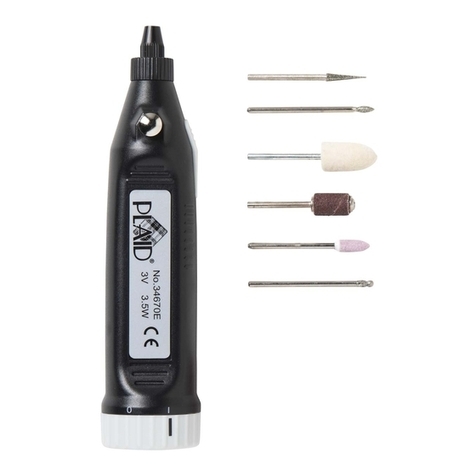
Plaid Systems
Plaid Systems ENGRAVER user guide

Clarke American Sanders
Clarke American Sanders Sander 1600DC Operator's manual
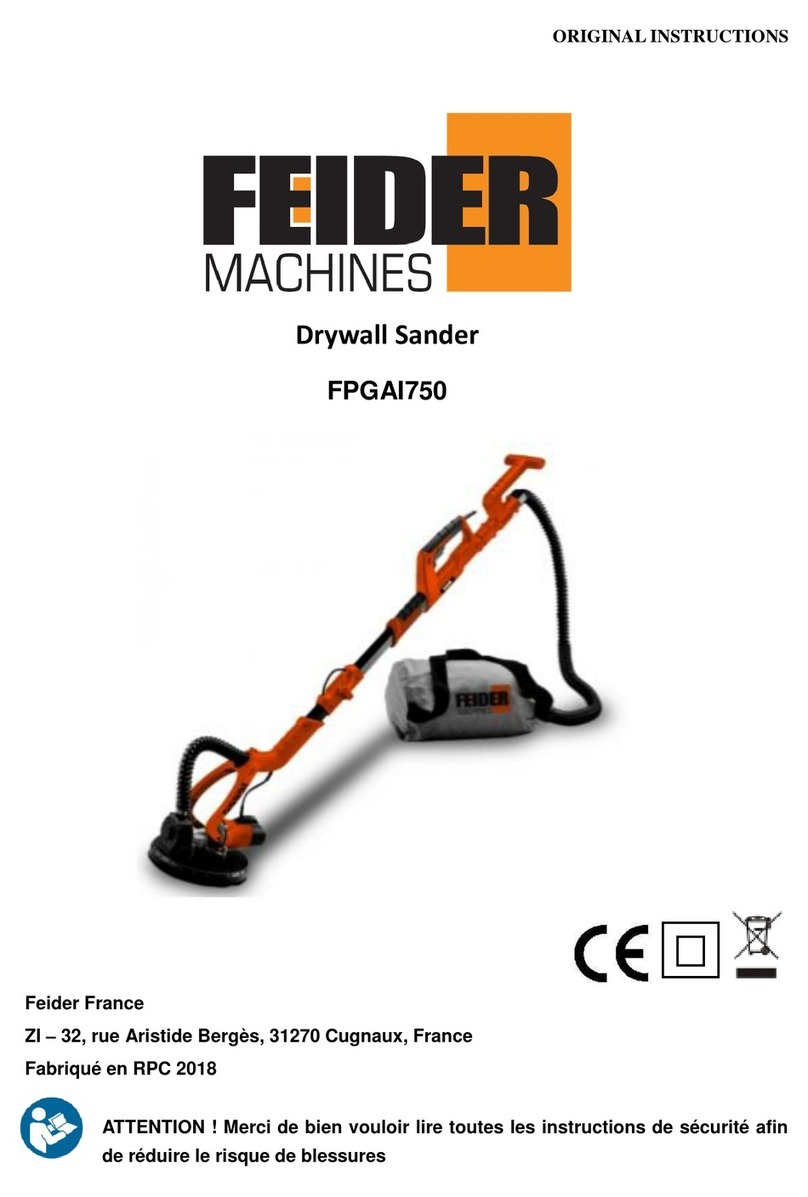
Feider Machines
Feider Machines FPGAI750 Original instructions

Zenit Powertools
Zenit Powertools GM-1000 instruction manual

Lux Tools
Lux Tools SWS 300 electronic Original operating instructions


